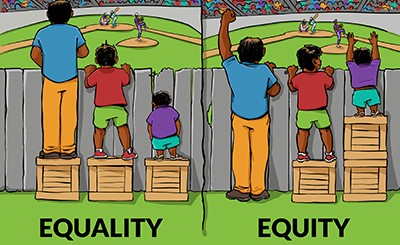PCG at SXSW EDU: New insights on “equality,” “equity” -- and what they mean for education

By Paul V. Wilson Jr., Senior Associate, Public Consulting Group
“Equity” and “Equality” are two words that look alike, sound alike, and but for the difference of two letters, would be identical.
But when it comes to delivering quality education for all children and young people, they are two words with profoundly different meanings and implications. However, many seem to not know the difference.
That’s a point we discuss often in education leadership circles and which was reinforced for me in a whole new way at this year’s SXSW EDU conference in Austin. At SXSW EDU, several of my Public Consulting Group (PCG) colleagues and I got to present with superintendents of three of the country’s biggest and most diverse school districts: Dr. Mark Bedell of Kansas City Public Schools, Dr. Paul Cruz of the Austin Independent School District, and Dr. Martha Salazar Zamora of the Tomball Independent School District, in metropolitan Houston’s Harris County.
As we continue to think through the equality-versus-equity challenge in public education, Dr. Bedell, Dr. Cruz, and Dr. Zamora equipped us with some powerful and innovative ways of thinking about these terms, the distinctions between them—and how those who teach and lead schools need to think and proceed as a result.
“Many people confuse equal access with equitable access,” Dr. Cruz says. “Equity is meeting people where they are and giving them the tools to get to where they want to be.”
“Equity,” says Dr. Bedell, “is about making sure students get what they need. It’s not about getting the same as others.”
Dr. Zamora painted a verbal image I’ll never forget: “Equity and equality form a type of double helix around our sense of fairness.”
Outside of the classroom, one thought-provoking analogy is that equality would be giving everyone in the world a pair of size-8 shoes. Equity, in contrast, would be giving everyone in the world a pair of shoes that fit.
Dr. Zamora, who was labeled profoundly deaf as a child, which inspired her to serve as both a special-education and general classroom teacher, says it would be rare if not impossible to find someone with classroom experience who would ever deny that students have differing needs: “The difficult part may be in helping them understand how this difference translates, or at least should translate, into different levels and forms of service.” This differentiated instruction might include more small-group time, one-on-one instruction, or other modifications and accommodations in testing and evaluation.
Dr. Cruz agrees that “our goal as a district is to remove the barriers that keep students from being successful, and some students need more support than others to achieve success. It is our job as educators to provide that differentiated level of support to our students so that they are all successful.”
“If you put it in the context of needing to close gaps,” Dr. Bedell says, “equity is extremely critical.”
In my pre-PCG career as a school-based and senior district administrator in the Broward County and Miami-Dade County school systems in Florida, and as the gubernatorial appointee to and Vice-Chair of the Florida Council on the Social Status of Black Men and Boys, my guidestar has been: From finance to curriculum, every educational decision we make must be analyzed and dissected through an equity lens.
This is not always easy. Sometimes educators are reluctant to acknowledge the inequities that exist, or how substantial they are and the scope of impacts they create. When one does not have an application for a specific set of life experiences, it is a daunting take to understand, respect, or empathize with the impact of those experiences. This line of conversation can make some people feel defensive, or create an environment that makes it difficult to express their true opinions.
All three superintendents offered wise encouragement and specific, actionable advice about this challenge. “Become comfortable with the uncomfortable,” Dr. Cruz says. “Honest conversations bring positive changes.”
The critical step for districts that Dr. Bedell stresses: “Make sure that you have an equity policy in place … and make sure you’re very intentional with how you decide what equity actually looks like for students in your school system. Be intentional, use data, and eliminate as much subjectivity as you can.”
“The most productive conversation will focus on the many examples of success resulting from a needs-based investment,” explains Dr. Zamora, “informed by the strong sense we all have of wanting equality, fairness, and justice.”
Special thanks to Dr. Bedell, Dr. Cruz, and Dr. Zamora for sharing their experiences with us during the “Equality v Equity: What’s the difference?” panel at SXSW EDU and for their contributions to this article.
Paul Wilson is a Senior Associate at Public Consulting Group (PCG) and subject matter expert in equity, access, leadership development, and curriculum development. Prior to PCG, Paul was an Administrative Director for Miami-Dade County Public Schools in the Office of School Operations/Special Programs. In this capacity, he helped to oversee all special programs for the district, including the 5000 Role Models of Excellence Project, a nationally recognized dropout prevention program that services over 8,000 at-risk minority males in over 100 schools in Miami-Dade County. For the past five years, Paul has served in the Governor-appointed role of Vice Chair to the Florida Council on the Social Status of Black Men and Boys.
